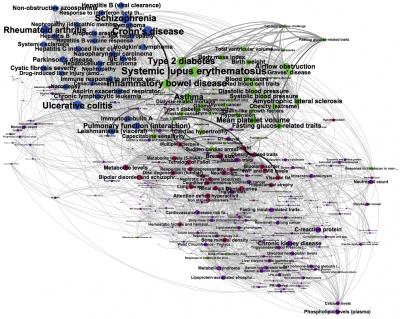CLOUD
Dartmouth researchers develop new tool to identify genetic risk factors

Dartmouth researchers developed a new biological pathway-based computational model, called the Pathway-based Human Phenotype Network (PHPN), to identify underlying genetic connections between different diseases as reported in BioDataMining this week. The PHPN mines the data present in large publicly available disease datasets to find shared SNPs, genes, or pathways and expresses them in a visual form.
"The PHPN offers a bird's eye view of the diseases and phenotype's relationships at the systems level," said Christian Darabos, PhD, post-doctoral fellow, Institute for Quantitative Biomedical Sciences (iQBS), Dartmouth College.
The PHPN uses information in human disease networks in conjunction with network science tools to show clusters of related disorders sharing common genetic backgrounds. It does so without the typical clinical classification of disease, in which all heart disease or all cancers are grouped together, based on clinical presentation. Dartmouth geneticists instead rely on the information contained in the PHPN's topology to automatically classify traits and diseases by their shared genetic mechanisms, such as common genes or pathways. PHPN explores the connections between the layers of the networks to find patterns and relationships.
"The intuitive network representation of the knowledge mined from several large-scale datasets makes the information accessible to anyone. It lies at the crossroads of computational genetics, systems biology, information theory, and network science," Darabos said.
PHPN supports the integration of genomic and phenotypic data to uncover significant links between traits, attributes, and disease. This offer tremendous potential in identifying risk factors for certain diseases. At the same time, it can reveal important targets for therapeutic intervention.
"As a proof of concept, the PHPN has proven capable of identifying well documented interactions, and many novel links that remain to be explored in depth," said Darabos.
The PHPN reveals biological connections between seemingly disparate displays of genetic properties and offers a unique view of the architecture of disease.
This tool can help researchers identify areas for further investigation based on connections it uncovers. "The PHPN is a hypothesis-generating tool, potentially capable of identifying yet uncharacterized common drug targets," said Darabos.
As a next step, iQBS researchers will refine statistical methods, isolate networks for optimal results, and compare previous work on phenotype networks.

